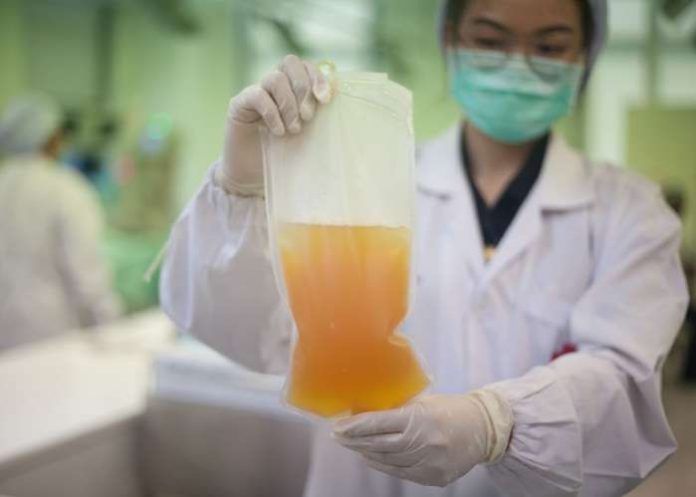By Agencies
COVID-19 research is advancing at an unprecedented speed, but one strategy doctors are leaning on to treat COVID-19 patients looks more antiquated than innovative. In hospitals around the United States, caregivers are resorting to using century-old convalescent plasma therapy — siphoning blood from survivors and reinfusing it into the sick.
That’s because the hundreds of research papers published in the past few months and the record-setting leaps in vaccine development haven’t been fast enough to keep up with the blistering speed of the ongoing pandemic. People are sick and dying now, which is why doctors are falling back on plasma therapy as one stop-gap measure that they hope can help in the lag time before other treatments come online.
“I think of it as a bridge, until we can develop a vaccine or pharmaceutical that can be shown to be safe, and effective, and can be produced in mass quantities,” says Elliott Bennett-Guerrero, who is studying the use of this convalescent plasma in COVID-19 patients at Stony Brook Medicine.
After someone is infected with a virus like the novel coronavirus and recovers, their blood is rich with antibodies their immune system produced to help them fight the virus off. Doctors hope that giving the antibody-infused blood plasma to a newly sick person, who may not have antibodies yet, could help them get better more quickly.
“With plasma we’re leveraging the body’s amazing ability to develop antibodies and immunity to pathogens,” Bennett-Guerrero says. “We transfer those protective factors to people who are sick and haven’t been able to mount an immune response.”
It’s been used as a treatment since at least the 1890s when blood from survivors was given to diphtheria patients. Studies during the 1918 flu pandemic showed that it was an effective treatment. It was used to managed dozens of illnesses in the century since, including measles and chickenpox.
Now, doctors hope it can help people with COVID-19. Preliminary data on a handful of patients in China showed that they got better after receiving a plasma infusion from survivors, but there’s still not enough data to say for sure that it works. Researchers in the US are running controlled studies to see if patients who receive the plasma improve faster than patients who don’t.
“It’s an old technique,” says Scott Koepsell, medical director in the division of transfusion and transplantation support services at the University of Nebraska Medical Center, who has collected plasma from Ebola survivors. He says that while plasma transfusions have been used for over a century, it’s still a treatment of last resort. “It’s a really well-meaning approach, but it has a lot of variability and limitations.”
For example, every person who survives an infection will have a slightly different mix of immune substances in their plasma. Each sick person treated with plasma, then, is getting a slightly different treatment. That can make it really difficult for a researchers to tell whether plasma therapy is generally effective (or ineffective) or whether it depends on if a patient gets a really good (or bad) batch of plasma. Medical researchers are trying to address this issue by only allowing survivors with high levels of antibodies to donate plasma, but the plasma will still vary from donor to donor.
In addition to the general uncertainty over how well these transfusions will work, there are also risks to any blood plasma transfusion: serious side effects can include lung injuries and allergic reactions.
Koepsell treated Ebola patients in the US with convalescent plasma during the outbreaks in 2014 and 2015. With Ebola, unlike COVID-19, there were additional benefits: plasma can also help prevent dangerous bleeding caused by that virus. Ebola was more likely to be dangerous for each person who got it, he says, making the risks easier to justify in the absence of clear evidence that plasma transfusions are effective.
In any outbreak, convalescent plasma has one major upside: it’s available as soon as someone survives a new illness. “The good thing is it’s readily available shortly after something happens,” Koepsell says.
Ideally, other, more standardized drugs specific to this disease would be available quickly, too. Those other drugs still take too long to get to patients — in part because there hasn’t been enough investment made to develop them. After the outbreaks SARS and MERS, which are also coronaviruses, scientists started work on possible treatments and vaccines. But with more distance from those outbreaks, the money dried up. Researchers doing that work aren’t as close to answers as they might have been if there’d been more sustained investment.
It’s possible to shrink the window between when a new disease appears and when treatments are available, Koepsell says, so that doctors aren’t left reaching for plasma. Investment in disease preparedness and steady work on antiviral drugs for pathogens like coronaviruses would give them more resources for the next outbreak.
“Hopefully we’ll have governments and institutions recognize that pandemics can come with more frequency,” he says. “I’d like to get away from collecting blood and transfusing it every time a new disease arrives.”





